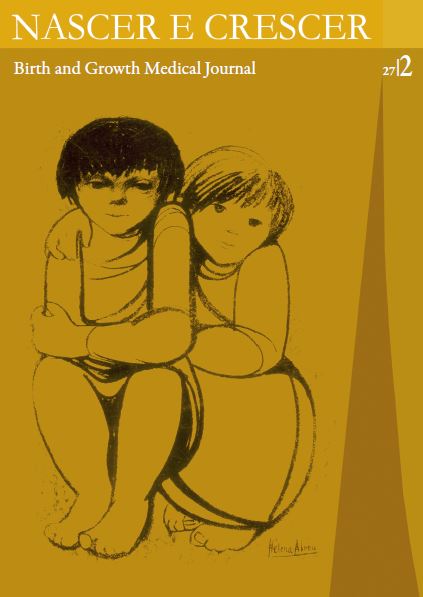Imaging case
DOI:
https://doi.org/10.25753/BirthGrowthMJ.v27.i2.13248Keywords:
Congenital diaphragmatic hernia, cough, failure to thrive, pediatricsAbstract
Introduction: Congenital Bochdalek Diaphragmatic Hernia (CBDH) is a relatively rare entity and may be underdiagnosed due to not being correctly recognized after the neonatal period.
Case report: An eight-month-old Caucasian infant with failure to thrive, presented to the emergency service with productive cough since the previous week. He was amoxicillin/ clavulanic acid prescribed seven days before for an acute otitis media and was afebrile for the past four days. Past history revealed failure to thrive and feeding difficulties. Chest radiograph was misleading, with multiple differential diagnosis, namely eventration and necrotizing pneumonia. Abdominal ultrasonography and thoracoabdominal magnetic resonance imaging revealed CBDH with non-obstructive gastric volvulus.
Discussion: Pediatricians should include late-onset CBDH as a differential diagnosis in any child with recurrent non-specific respiratory or gastrointestinal tract symptoms. Early surgical correction of diaphragmatic defect is crucial to prevent the possible risk of strangulation and severe respiratory problems.
Downloads
References
Cevizci MN, Erdemir G, Cayir A. A Rare Cause of Haemorrhage in the Upper Gastrointestinal System: Bochdalek Hernia. West Indian Med J 2015; 64:154-6.
Chang SW, Lee HC, Yeung CY, Chan WT, Hsu CH, Kao HA, et al. A twenty-year review of early and late-presenting congenital Bochdalek diaphragmatic hernia: are they different clinical spectra? Pediatr Neonatol 2010; 51:26-30.
Cigdem MK, Onen A, Otcu S, Okur H. Late presentation of bochdalek-type congenital diaphragmatic hernia in children: a 23-year experience at a single center. Surg Today 2007; 37:642-5.
Bagłaj M, Dorobisz U. Late-presenting congenital diaphragmatic hernia in children: a literature review. Pediatr Radiol 2005; 35:478-88.
Bagłaj M. Late-presenting congenital diaphragmatic hernia in children: a clinical spectrum. Pediatr Surg Int 2004; 20:658-69.
Al Ghafri M, Al Sidairi I, Nayar M. Late presentation of congenital diaphragmatic hernia: a case report. Oman Med J 2014; 29:223-5.
Mei-Zahav M, Solomon M, Trachsel D, Langer JC. Bochdalek diaphragmatic hernia: not only a neonatal disease. Arch Dis Child 2003; 88:532-5.
Radović SV. Late Presentation of Congenital Diaphragmatic Hernia - Case Report. Srp Arh Celok Lek 2015; 143:604-8.
Rankin JH, Elkhunovich M, Seif D, Chilstrom M. Point-of-Care Ultrasound Diagnosis of Diaphragmatic Hernia in an Infant With Respiratory Distress. Pediatr Emerg Care 2016; 32:731-3.
Kitano Y, Lally KP, Lally PA. Congenital Diaphragmatic Hernia Study Group. Late-presenting congenital diaphragmatic hernia. J Pediatr Surg 2005; 40:1839-43.
Downloads
Published
How to Cite
Issue
Section
License
Copyright and Authors' Rights
All articles published in Nascer e Crescer - Birth and Growth Medical Journal are Open Access and comply with the requirements of funding agencies or academic institutions. For use by third parties, Nascer e Crescer - Birth and Growth Medical Journal adheres to the terms of the Creative Commons License "Attribution - Non-Commercial Use (CC-BY-NC)".
It is the author's responsibility to obtain permission to reproduce figures, tables, etc. from other publications.
Authors must submit a Conflict of Interest statement and an Authorship Form with the submission of the article. An e-mail will be sent to the corresponding author confirming receipt of the manuscript.
Authors are permitted to make their articles available in repositories at their home institutions, provided that they always indicate where the articles were published and adhere to the terms of the Creative Commons license.


